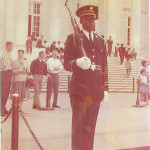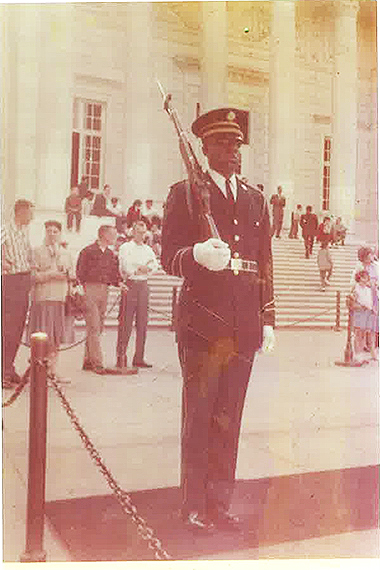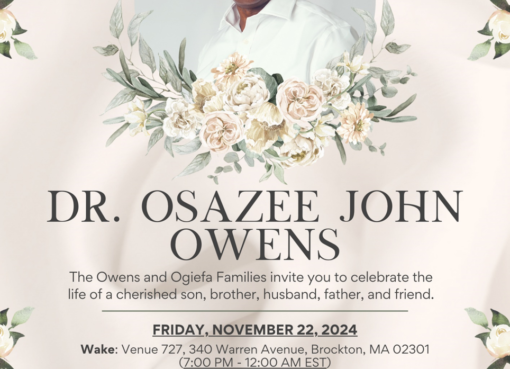By Jacqueline M. Hames
Soldiers Magazine
WASHINGTON – Arlington National Cemetery rests on an expanse of rolling hills in northern Virginia. One of the busiest tourist spots in the cemetery is the Tomb of the Unknown Soldier, which sits at one of the highest points in the cemetery.
Though there is a spectacular view of Washington, D.C., visitors don’t pay much attention to the scenery.
They are focused on the white marble sarcophagus and the lone soldier who guards it, 21 steps at a time. While there has been a 24-hours-a-day, seven days a week military guard at the Tomb since July of 1937, the 4th Battalion, 3d U.S.
Infantry Regiment (The Old Guard) didn’t assume its watch until 1948. And it wasn’t until 1960 that the Tomb Guard selected its first African American soldier to “walk the mat.”
Drafting and Recruitment

Specialist 4th Class Fred Moore, the first African American posted to the Tomb Guard, was drafted Aug. 13, 1959, and left his home in Cleveland, Ohio, for basic training shortly after.
He wasn’t pleased with being selected and spent the first part of his training thinking about how he could go back home.
“When I got my letter from the government telling me that I had been selected, I was upset because I was working, and a lot of the guys, the friends that I knew they weren’t working,” Moore said.
“And I had a job, and then when I went into the service, they were still doing what they were doing, and it just kind of rubbed me the wrong way.”
One night, Moore’s platoon sergeant lined up the new recruits and asked how many of them had been drafted.
He sympathized, acknowledging that the draftees might have a few complaints about being in the service. And then he reminded everyone, “The Army can do more to you than you can do to it.”
“So, I just said ‘OK, I’m going to straighten up, I’m going to do the best I can, and make the best of it,’ and it worked out real well for me,” Moore said.
Moore was sent to the reception center at Fort Knox, Kentucky, during training. He and the other recruits were subjected to a series of tests over three days before they were given any assignments.
An officer called Moore into his office and noted that Moore had scored exceptionally well on the tests.
He went on to emphasize Moore’s physical build: 185 pounds, 6 feet 1 inch, and asked Moore if he’d like to be in Honor Guard Company.
“Well, I didn’t have a clue as to what he was talking about, I didn’t know what Honor Guard Company was,” Moore said.
The officer explained it was a spit-and-polish outfit, so Moore agreed to the assignment. When he received his orders after training, he was a little disappointed because his fellow soldiers were all going to exciting places, like South Korea and Germany, and Moore had to say he was going to Fort Myer, Virginia.
Honor Guard Company is the nickname for The Old Guard’s Company E, 4th Battalion. The company also comprises an escort platoon, a casket platoon, a firing party and a continental color guard. When Moore arrived in late 1960, he was assigned to the firing party.
“You were busy all the time. You were busy, just about every day. When I first got there, once I got my training and settled into the company, I was on the military firing party, we did military funerals in Arlington National Cemetery,” Moore recalled.
“We fired the rifles over the graves, and we did that five days out of the week. Sometimes, we would have burials every half-hour on the hour.”
When the weather was good, the company would participate in parades and ceremonies, sometimes functioning as a ceremonial guard for visiting dignitaries.
“I was in the inaugural parade for John F. Kennedy. Kennedy was just coming in and Eisenhower was going out, and also … I was part of his inaugural ball. I was part of the outfit that performed,” Moore added.
Tomb Guard
Now-retired Army Col. Neale Cosby, who served as a platoon leader with the Tomb Guard and was the Honor Guard Company’s basketball coach, had first choice of the soldiers qualified to stand watch of the Tomb.
He selected Moore for duty under the Headquarters and Headquarters Company, 4th Battalion and assigned him to Quarters Number 1, in preparation for Tomb Guard duty.
“I got to know him on the basketball court, and like him, and respect him. Not only was he a good soldier, but he was a good guy, he was a very steady guy, an all-American soldier,” Cosby said.
He added that soldiers on the Tomb Guard should be able to present themselves well at attention, have straight posture, be coordinated at handling a rifle and be able to keep the 21-count well. Moore seemed to possess all those qualities.
“Plus the fact that … you don’t want just good soldiers. You want good citizens, good Americans, good people, and he was all that,” Cosby said. “I could tell that. And it was not, in fact, it did not skip my mind that he was black and none had ever served there. And I thought it was the right thing to do, and I looked around and I thought, ‘This guy’s got everything, why don’t I do it?’”
In January of 1961, President Kennedy brought the president of Ghana, Kwame Nkrumah, to the Tomb for a wreath-laying ceremony.
Nkrumah asked Kennedy why he didn’t see any people of color on the Tomb Guard, Moore explained.
Nkrumah’s concern became Kennedy’s, and orders traveled down the chain of command in The Old Guard. Moore, already in line for Tomb duty, was moved quickly into a sentinel position.
“The next thing I know, the word came back to the company that they told me to get my stuff, I was moving out of the 3rd Platoon, I was going down to the Tomb Guard platoon, I was going into training, and that was in January.
So I went into training in January and in March I became a guard at the Tomb of the Unknown Soldier,” he said.
Then-Spc. 4th Class John Ranum was on the relief (a relief is the shift a guard is assigned) that Moore joined, and described Moore as a “straight trooper.”
“He had to be good. Well, we all had to be pretty good, but … he was exceptional,” Ranum said of Moore.
Moore wasn’t nervous for his first shift of sentinel duty because the training had prepared him well. However, he remembered it being a little overwhelming.
That first crowd felt like the largest crowd of the day to Moore. He added that stepping onto the mat for the first time was a “great feeling.”
He was unaware he was the first black soldier on a Tomb Guard relief until an article came out in Ebony magazine in September 1961.
The Tomb Guard reliefs were organized differently during the 1960s, with 12 soldiers on duty as sentinels.
There were three reliefs, Ranum explained, with four men on each relief working in 24-hour shifts. Ranum said the more difficult times to walk the mat were at night, or in bad weather.
“It was easier with the people around, because if there was no one there — which was very rare, maybe the first hour in the morning — you had to be just as straight as [with] the people there, because you never knew,” he said.
“Every day was different, every walk was different, and it was just very interesting to watch people, although we had to look straight ahead practically all the time.
It was interesting to see the effect the place has on people and sometimes you could just tell that someone … had a real interest and was nostalgic about being there. Very moving.”
Ranum and Moore served on the same relief for about six months and grew very close. One day, during the height of summer, Moore recalled relieving Ranum from his post.
It had been raining off and on all day, so Moore had gone on duty with a rain jacket. The moment he stepped on the mat, it stopped raining.
When he came off the mat after his half-hour walk, he took the jacket off. On his next walk, he went out without the rain jacket, and sure enough it started raining.
Things went on this way over the course of the day: Whenever Moore was prepared for rain, it was sunny; when he dressed for clear skies, it drizzled.
Ranum spent the whole shift laughing at him, like any good friend would.
Moore remembers soldiers talking about being uncomfortable while on duty at night in a cemetery, but he’s not sure why it made some people nervous.
When the moon was out, the white marble of the amphitheater reflected the light, making the area extremely bright.
“You could see a chipmunk,” Moore remembered.
Proud to Serve
Moore was drafted into the Army during a tumultuous period for civil rights, when racial discrimination was rampant. However, he said he didn’t experience that in the Army, and he got along well with his fellow soldiers.
“To tell you the truth, I considered myself blessed because I didn’t have any problems whatsoever. No problems, no problems at all,” he said. He credits that blessing to being around other good people.
After Moore’s duty as a Tomb sentinel was over, he went on to the Noncommissioned Officers Academy and graduated with honors.
He went home to Cleveland after his two-year service requirement ended. He lost touch with Ranum, Cosby and other members of his relief until 1998, when he went to a reunion of the Society of the Honor Guard, Tomb of the Unknown Soldier.
The society, which is a 501(3)(c) organization with the goal of protecting and enhancing the image of the Tomb and the soldiers who stand guard, was founded by Cosby and four former sentinels.
Moore hadn’t seen anyone from his Army days in 37 years, and had to reschedule another family function to attend the society’s reunion. When his wife, Joyce, found out about the reunion, she was insistent that they attend, Moore said.
“So we went down and we just had a fantastic time, you know, and it was strange, and then younger guys that had been guards down there, as soon as they heard my name they knew who I was, and I was kind of baffled,” he said.
So many people wanted to take pictures with him and knew his name that he had to ask what was going on. He discovered he was part of the Tomb Guard test; soldiers had to know who the first African American sentinel was in order to become sentinels themselves.
Moore has been to as many bi-annual reunions with the society as possible, and when he goes, new sentinels tell him that he “paved the way,” but Moore said he is more proud of them than they are of him.
“They’ve just elevated (the position) and that’s what makes me proud,” he said.
(EDITOR’S NOTE: In 1997, Army Sgt. Danyell E. Wilson became the first female African American Tomb Guard.)




